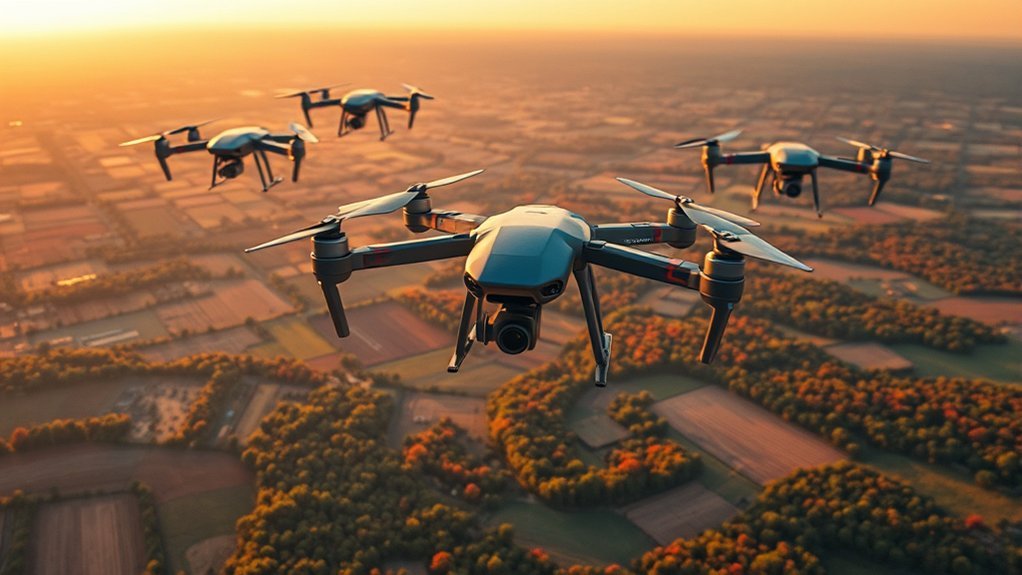In 2025, aerial mapping is set to transform with innovative drones that can enhance your surveying capabilities. You’ll find options equipped with high-resolution cameras and advanced stabilization features, making data collection more precise than ever. But what should you consider when choosing the right drone for your needs? Let’s explore the top contenders that promise to elevate your surveying game and help you make informed decisions.
Mini Drone with Camera for Adults (8K/4K HD Video)
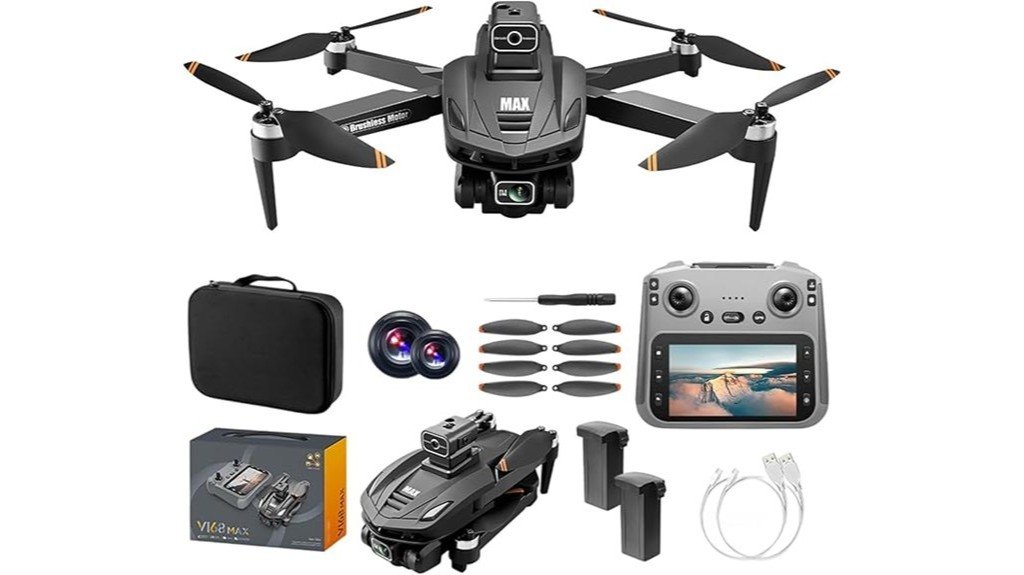
If you’re an adult looking to elevate your aerial mapping game, the Mini Drone with Camera for Adults featuring 8K/4K HD video is an excellent choice. This drone captures ultra-crisp 8K photos and 4K/30fps videos, turning your everyday moments into cinematic treasures. With its 4-direction obstacle avoidance and GPS Auto Return Home, you can fly confidently in complex environments. Enjoy up to 60 minutes of flight time with two included batteries, and operate easily with One-Key Takeoff/Landing and Altitude Hold. Its compact design makes it perfect for travel, ensuring you’re always ready for stunning aerial photography.
Best For: Adults seeking a high-quality, portable drone for capturing stunning aerial photography and videography.
Pros:
- Ultra-crisp 8K photo and 4K/30fps video quality for cinematic content.
- Safety features like obstacle avoidance and GPS Auto Return Home provide added peace of mind.
- Compact and foldable design makes it travel-friendly, perfect for outdoor shoots.
Cons:
- May have a learning curve for complete beginners despite user-friendly controls.
- Limited to 60 minutes of flight time with two batteries, which may require planning for longer sessions.
- Higher price point compared to basic drones on the market.
24X24 Drone Survey Ground Control Point GCP (6 pcs)
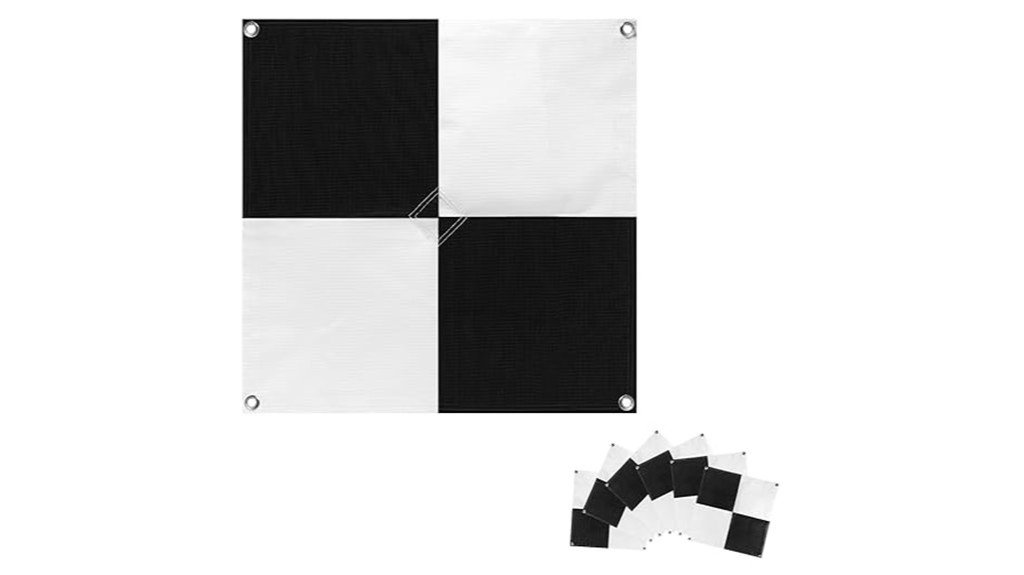
The 24X24 Drone Survey Ground Control Point (GCP) is an essential tool for professionals in aerial mapping, particularly those in surveying, construction, and education. This set includes six GCPs, designed for UAV aerial surveys, visible from 400 feet. The black and white checkerboard pattern enhances visibility and guarantees clearer images, while the central opening allows for easy coordinate measurement. Made from PVC and reinforced with polyester mesh, these lightweight GCPs reduce glare and improve data accuracy. You’ll find them cost-effective, providing reliable performance and facilitating precise mapping without the hassle of repositioning during flights. Elevate your surveying game with these GCPs!
Best For: Aerial survey professionals, including those in surveying, construction, and education, looking for reliable and efficient ground control solutions.
Pros:
- High visibility from 400 feet ensures clarity in aerial imaging.
- Durable construction with PVC and polyester mesh for long-term use in various environments.
- Cost-effective compared to DIY solutions, offering reliable performance and precise data collection.
Cons:
- Limited to low to mid-altitude UAV mapping, which may not suit all flight needs.
- Requires secure fixing at each corner, which may complicate setup in some locations.
- Potential for wear over time with prolonged exposure to outdoor elements.
Bwine F7 Pro Drone with Camera for Adults
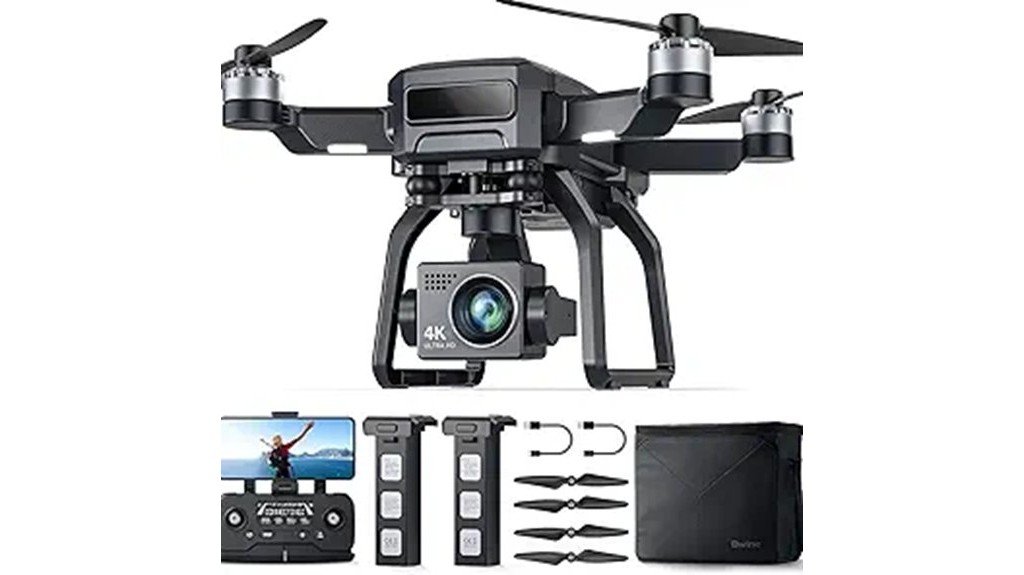
For aerial mapping enthusiasts looking for a reliable and user-friendly option, the Bwine F7 Pro Drone stands out with its impressive 4K UHD camera and advanced 3-axis gimbal stabilization. You’ll appreciate the 50 minutes of flight time offered by two intelligent batteries, while the 10,000 ft control range guarantees expansive coverage. With features like GPS Follow, Waypoint navigation, and Auto Return, your mapping tasks become seamless. Plus, the 5x digital zoom and adjustable 90°/120° FOV lens enhance your aerial photography capabilities. Weighing just 550 grams, it’s perfect for both beginners and seasoned pros in the field.
Best For: Aerial mapping enthusiasts and hobbyists seeking a reliable drone with advanced photography features and user-friendly controls.
Pros:
- 4K UHD Camera: Captures high-resolution images and videos with stunning clarity.
- Long Flight Time: Offers up to 50 minutes of flight time with two intelligent batteries.
- User-Friendly Features: GPS Follow, Waypoint navigation, and Auto Return make it easy for beginners to use.
Cons:
- Charging Time: Takes approximately 6.5 hours to fully charge the batteries.
- Weight: At 550 grams, it may be slightly heavier than some other drones in its class.
- Limited Zoom: The 5x digital zoom may not suffice for detailed close-up aerial shots compared to higher-end models.
Drone Ground Control Point GCP for UAV Aerial Survey Mapping (2 Pack)
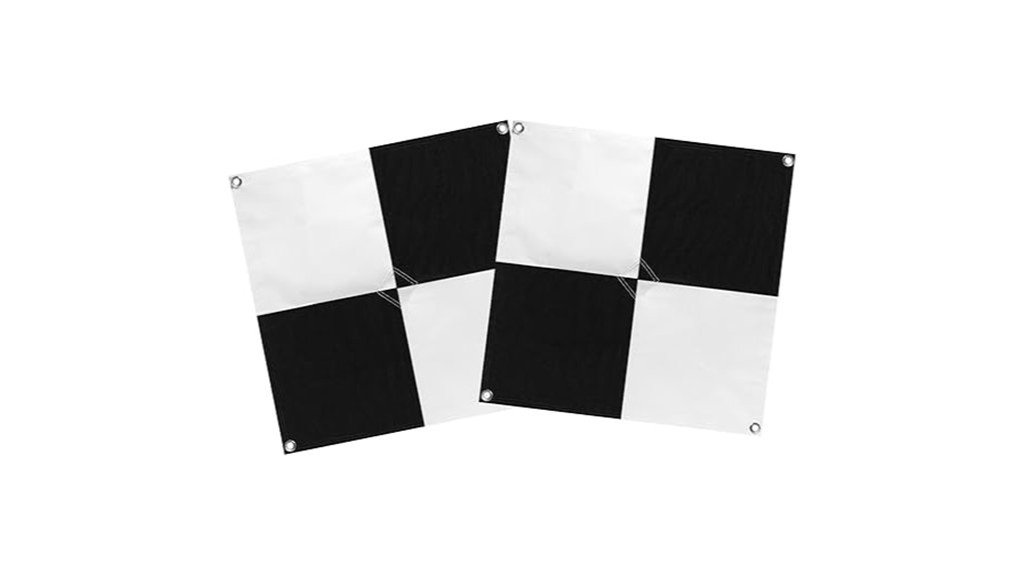
Engineered specifically for UAV aerial survey mapping, the Drone Ground Control Point (GCP) offers unmatched precision and efficiency for professionals in surveying and mapping. This 2-pack set features a center eyelet for easy insertion and corner anchor points for secure placement. The black and white checkerboard design enhances visibility and guarantees accurate data capture across various lighting conditions. Constructed from durable PVC and polyester mesh, these lightweight markers reduce glare, making them ideal for field use. Cost-effective and compatible with most surveying software, the GCP is your go-to solution for optimized drone operations and reliable data collection in aerial mapping.
Best For: Professionals in surveying and mapping who require precise and efficient aerial data collection.
Pros:
- High visibility: The black and white checkerboard design ensures clear visibility for accurate data capture in varied lighting conditions.
- Durable construction: Made from PVC coated polyester mesh, these GCPs are lightweight yet robust, suitable for repeated field use.
- Cost-effective solution: Offers superior performance compared to homemade alternatives, simplifying map scaling and verification processes.
Cons:
- Limited flight altitude: Designed specifically for low to mid-altitude UAV mapping, which may not suit all surveying needs.
- Requires secure placement: Corner anchor points necessitate careful setup to ensure stability during use.
- Dependence on weather: Field performance can be affected by adverse weather conditions, which may impact visibility and data accuracy.
Sky High Bulls-Eye Disposable Ground Control Points for Aerial Mapping & Surveying (100 Pack)
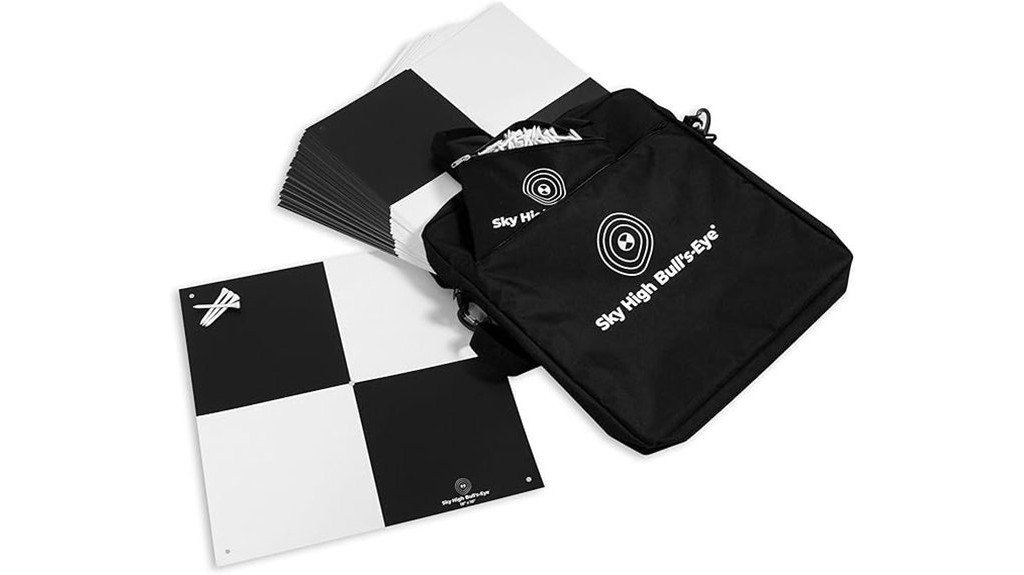
Sky High Bulls-Eye Disposable Ground Control Points (GCPs) are an essential tool for drone operators focusing on aerial mapping and surveying. Each pack includes 100 GCPs and 500 wooden stakes, making setup a breeze. Measuring 18” x 18”, these lightweight cardstock targets feature a matte finish that reduces glare, ensuring visibility. Their black and white checkerboard pattern aligns perfectly with photogrammetry software like Pix4D and DroneDeploy. Plus, the center hole allows for precise equipment alignment, while corner holes provide stability in windy conditions. This economical solution is perfect for capturing accurate survey data in remote locations, enhancing your mapping projects.
Best For: Sky High Bulls-Eye Disposable Ground Control Points are best for drone operators and surveyors looking for an efficient and cost-effective solution for aerial mapping and surveying.
Pros:
- Easy to set up with included 500 wooden stakes for anchoring.
- Lightweight and portable, making them ideal for remote locations.
- Matte finish and checkerboard design enhance visibility and compatibility with photogrammetry software.
Cons:
- Disposable nature may not appeal to users looking for reusable solutions.
- Limited to specific dimensions (18” x 18”), which may not suit all project needs.
- Requires additional tools (like 60D nails) for optimal ground control establishment.
10 Pack Drone Ground Control Point Markers for Mapping & Surveying
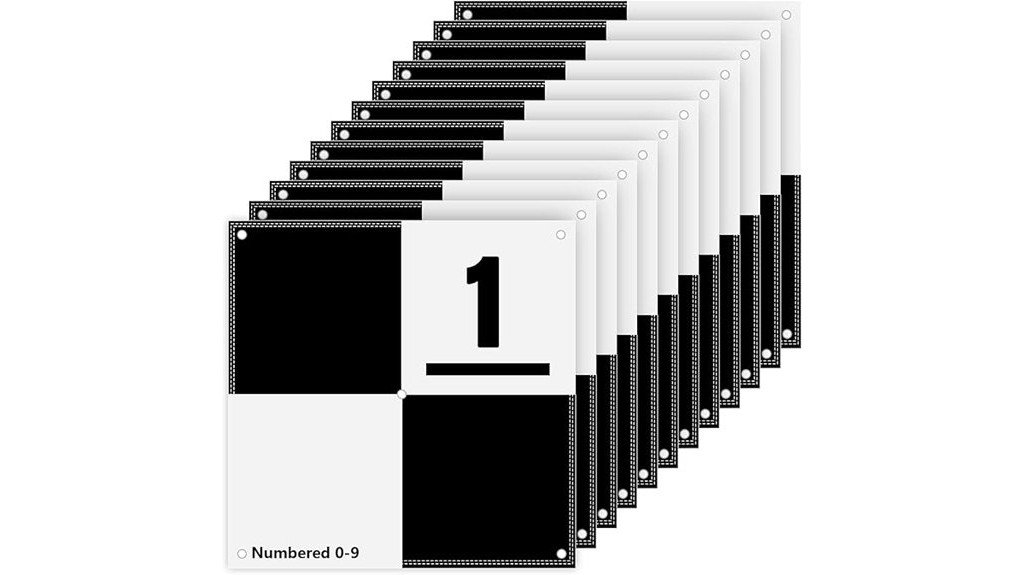
When it comes to precision in aerial mapping and surveying, the 10 Pack Drone Ground Control Point (GCP) markers stand out as essential tools for professionals in the field. Measuring 24×24 inches, their black and white checkerboard pattern makes identification easy, while the numbers 0-9 help you track specific coordinates. Made from durable Oxford cloth, these markers are wear-resistant, scratch-resistant, and waterproof, ensuring they withstand various conditions. With secure fixing options and positive customer feedback, you’ll find these GCPs enhance your project’s efficiency and accuracy, solidifying your surveying game in 2025 and beyond.
Best For: Professionals in aerial mapping and surveying looking for reliable ground control point markers.
Pros:
- High visibility with a black and white checkerboard pattern and clear numbering.
- Durable construction with wear, scratch, and waterproof properties.
- Secure fixing options make them suitable for use in windy environments.
Cons:
- Limited to a specific size of 24×24 inches, which may not suit all project needs.
- Only includes numbers 0-9, which may be limiting for larger projects requiring more markers.
- Requires physical setup and securing, which may be time-consuming in the field.
Ruko F11PRO 2 Drone with 6K Camera
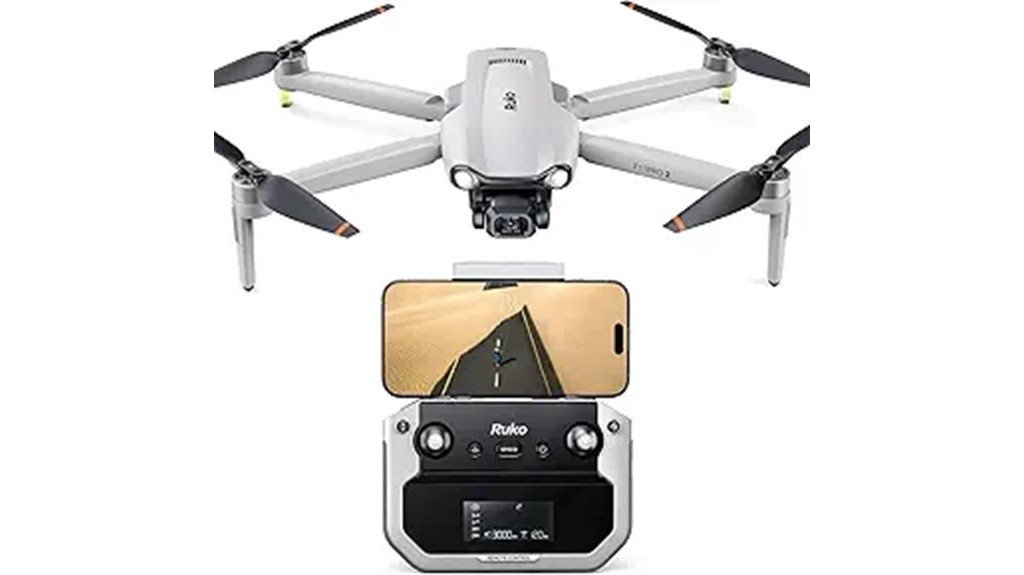
For those seeking high-quality aerial mapping capabilities, the Ruko F11PRO 2 Drone with a 6K camera stands out as an exceptional choice. Its advanced image sensor captures stunning 6K photos and 4K/30fps video, ensuring every detail pops with vibrant colors and clarity. The 3-axis brushless gimbal provides stability, making your footage smooth even in windy conditions. With intelligent flight modes like follow-me and waypoint planning, you’ll find it easy to operate, whether you’re a beginner or a pro. Plus, the extended flight time of 70 minutes allows you to cover larger areas efficiently, making it perfect for all your mapping needs.
Best For: Aerial photography enthusiasts and professionals looking for high-quality imaging and easy-to-use drone features.
Pros:
- 6K photo and 4K video capabilities provide stunning image quality and detail.
- Intelligent flight modes make it user-friendly for both beginners and experienced pilots.
- Extended flight time of 70 minutes allows for extensive aerial mapping and exploration.
Cons:
- Requires the use of the Ruko charger for optimal performance, limiting charging options.
- Larger size may make it less portable compared to smaller drones.
- Some advanced features may require a learning curve for new users.
GeoGear 6 Pack Drone Ground Control Point GCP for Aerial Mapping
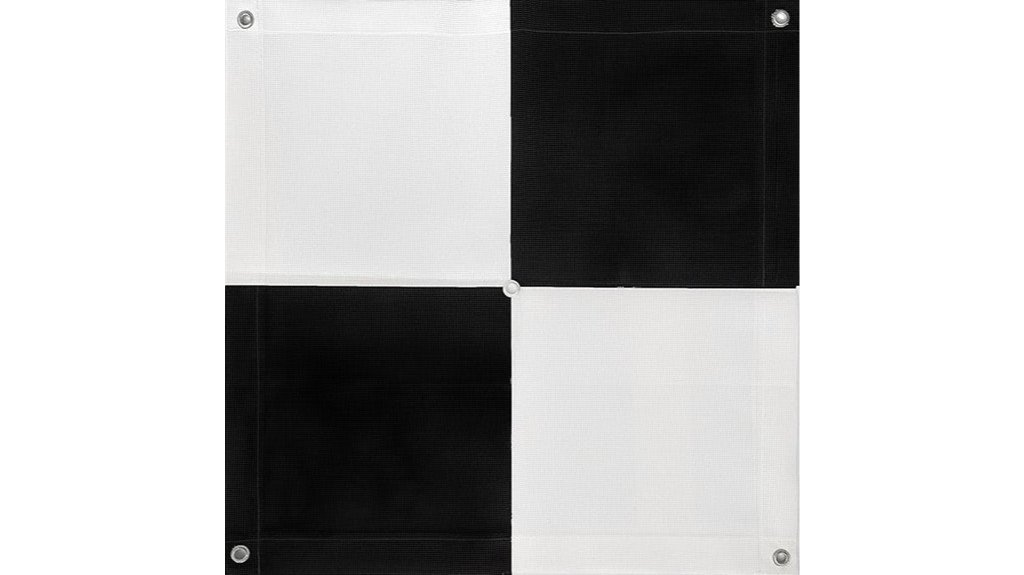
The GeoGear 6 Pack Drone Ground Control Point (GCP) is an essential tool for professionals in surveying and construction who need reliable precision in aerial mapping. Each 24”x24” GCP features a durable, weather-resistant vinyl mesh design that’s lightweight yet highly visible. The center eyelet allows for precise placement with a survey rod, while corner eyelets guarantee stability during scans. Compatible with top photogrammetry software, these GCPs excel in low to medium-altitude mapping. Users praise their effectiveness and durability, making them a cost-effective choice for repeated use. Elevate your aerial mapping game with this versatile and practical solution.
Best For: The GeoGear 6 Pack Drone Ground Control Point (GCP) is best for surveying and construction professionals seeking reliable precision in aerial mapping.
Pros:
- Durable and lightweight: Constructed from weather-resistant vinyl mesh, ensuring portability and longevity.
- High visibility: The black and white checker pattern enhances visibility during aerial scans.
- Compatible with photogrammetry software: Works seamlessly with leading software like Pix4D and DroneDeploy for effective mapping.
Cons:
- Color visibility issues: Some users report that the checker pattern may not stand out well in certain lighting conditions.
- Limited size options: The 24”x24” dimensions may not suit all project requirements.
- Potential for wear with heavy use: Though durable, repeated exposure to harsh conditions may affect long-term performance.
Sky High Bulls-Eye Drone Ground Control Point GCP (10 Pack)
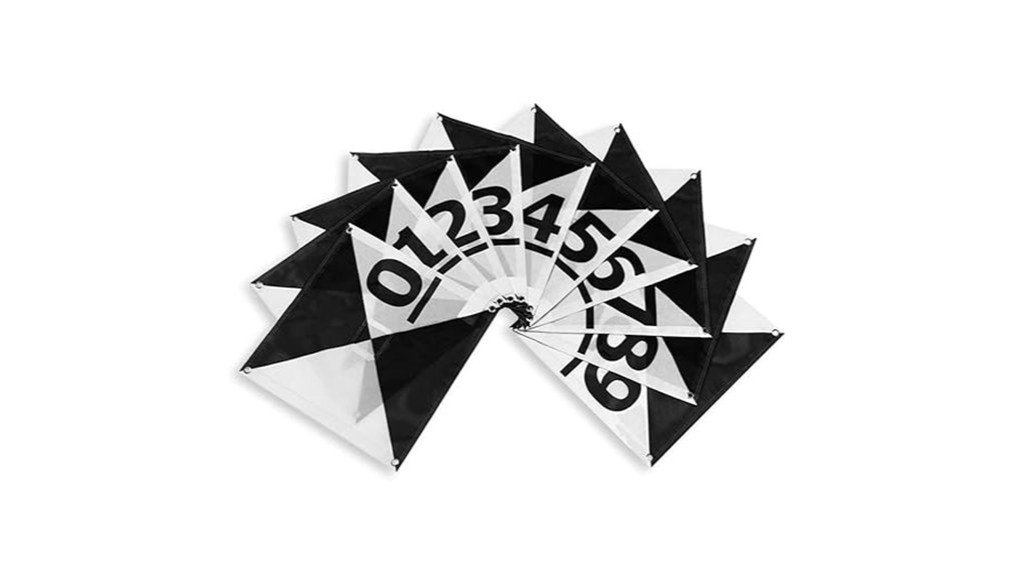
Sky High Bulls-Eye Drone Ground Control Point GCP (10 Pack) is ideal for professional surveyors and mapping enthusiasts who need reliable data capture in their aerial projects. With unique center cutouts, you can easily align your drone camera to existing survey points, streamlining your workflow. Each marker boasts four corner anchor points, ensuring stability even in challenging conditions. The numbered markers (0-9) help you quickly identify targets, boosting your efficiency in the field. Crafted from durable materials, these lightweight, foldable markers are easy to transport, making them perfect for various job sites. Elevate your mapping game with this essential tool!
Best For: Professional surveyors and mapping enthusiasts seeking reliable and efficient aerial data capture.
Pros:
- Efficient workflow with center cutout design for easy alignment with existing survey points.
- Stable placement ensured by four corner anchor points, providing precise results in various conditions.
- Durable and portable construction allows for repeated use and easy transport across job sites.
Cons:
- Limited to a specific number of markers (0-9), which may not accommodate larger projects.
- Requires manual setup and anchoring, which could be time-consuming in some scenarios.
- May not be suitable for all terrains if not properly affixed, potentially affecting data quality.
GPS Drone with Camera and 4.5 LCD Screen
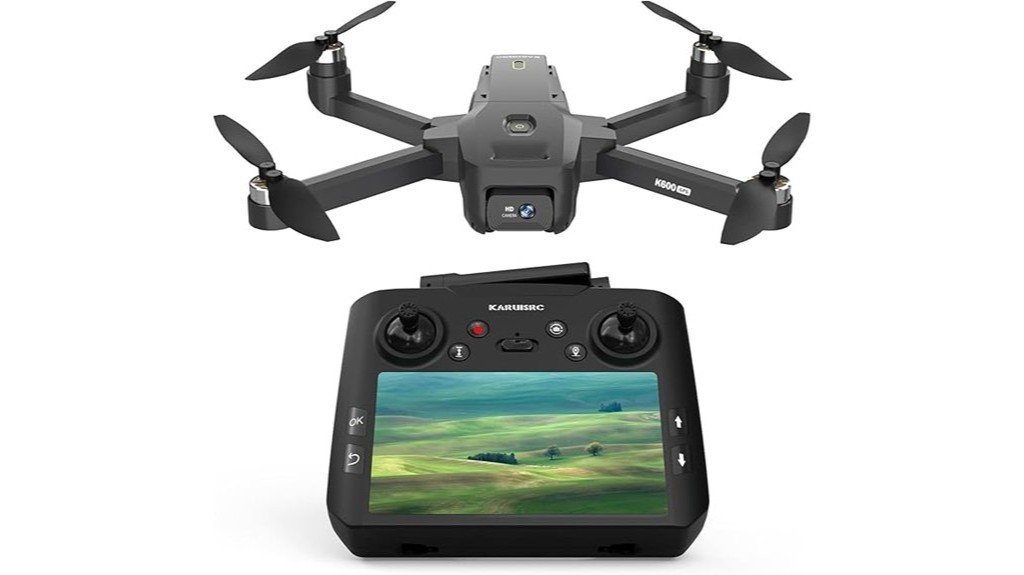
If you’re looking for an easy-to-use drone that excels in aerial mapping, the GPS Drone with Camera and 4.5 LCD Screen is an excellent choice. Weighing just 205.8 grams, it’s lightweight and portable, making it perfect for outdoor use. The 4.5-inch HD screen lets you preview and transmit footage in real-time, while the advanced HD camera captures vibrant landscapes with professional color accuracy. With a control range of 400 meters and a mapping capability of 250 meters, you’ll get reliable performance. Plus, its one-touch operation saves your photos and videos directly to the included 32G SD card.
Best For: Those seeking a lightweight, user-friendly drone for capturing high-quality aerial footage and mapping.
Pros:
- Lightweight and portable design at just 205.8 grams, making it easy to carry for outdoor adventures.
- Real-time transmission and previewing of footage on a 4.5-inch HD screen for seamless operation.
- User-friendly features like one-touch operation for saving photos/videos directly to the included SD card.
Cons:
- Limited control range of 400 meters may restrict flying distance for advanced users.
- Wind resistance may vary, potentially affecting performance in gusty conditions.
- Battery life information not specified, which could impact prolonged use during outings.
Factors to Consider When Choosing a Drone for Aerial Mapping
When choosing a drone for aerial mapping, you’ll want to take into account several key factors that can impact your results. Camera resolution, flight time, and stability are essential, but don’t overlook the importance of GPS functionality and ground control points. Each element plays a role in ensuring accurate and efficient mapping outcomes.
Camera Resolution Importance
While selecting a drone for aerial mapping, understanding the importance of camera resolution is essential to capturing high-quality images. Higher resolutions, like 4K (3840×2160) or even 6K, provide more detail, enabling clearer images for accurate evaluation. If you opt for 8K photos, you’ll notice greatly enhanced quality, offering finer details and richer textures for professional applications.
Capturing high-resolution video at 30fps enhances motion smoothness, critical for evaluating dynamic environments. Additionally, better resolution improves photogrammetry software‘s effectiveness, facilitating automatic recognition and boosting survey efficiency. Ultimately, a well-resolved image contributes to improved georeferencing and scaling, crucial for creating precise maps and models in aerial surveying tasks. Prioritize camera resolution for the best mapping results.
Flight Time Duration
Considering the critical role flight time plays in aerial mapping, it’s essential to choose a drone that meets your project’s specific needs. Many drones offer flight times between 25 to 70 minutes, depending on battery capacity. Longer flight times minimize the need for frequent battery changes, allowing for continuous mapping sessions and reducing downtime. If you’re tackling larger projects, consider drones with dual battery systems for extended flight durations. Keep in mind that factors like wind resistance, payload weight, and flight conditions can influence flight time. Consequently, it’s crucial to align the drone’s capabilities with your mapping requirements, as longer durations enable more thorough data collection over expansive areas, enhancing the overall efficiency of your surveying tasks.
Stability Features Required
To achieve high-quality aerial mapping, you need a drone that offers exceptional stability during flight. Look for models equipped with 3-axis gimbals, as these greatly reduce camera shake and enhance image quality. Drones with brushless motors provide better stability, maintaining consistent power output and adapting to changing wind conditions. A stable drone can hold its position effectively, ensuring precise data collection during mapping missions. Additionally, a robust flight control system with advanced sensors for wind resistance and altitude stabilization is vital for performance in various environments. For best results, choose drones capable of stable flight at low to mid-altitudes, typically up to 400 feet, essential for detailed aerial surveying and mapping.
GPS Functionality Necessity
GPS functionality is essential for aerial mapping, as it guarantees your drone captures precise geographical data and coordinates. When choosing a drone, look for one equipped with advanced GPS features, enabling automated flight paths. This assures consistency and repeatability in data collection, as your drone can effortlessly return to specific locations. Safety is another key benefit; features like Auto Return Home allow your drone to return to its launch point if the signal is lost or the battery runs low. Additionally, GPS integration helps with waypoint planning, letting you define specific flight routes. This optimizes mapping efficiency and reduces the time you spend manually controlling the drone, making your aerial mapping projects smoother and more effective.
Ground Control Points
When starting on aerial mapping projects, incorporating Ground Control Points (GCPs) greatly boosts the accuracy of your data. GCPs serve as reference markers, helping to align and georeference the images captured by your drone. Look for GCPs with a black and white checkerboard pattern, as this is compatible with most photogrammetry software, enhancing survey efficiency. Opt for high-quality GCPs made from durable materials like PVC or vinyl mesh, ensuring they withstand various weather conditions and reduce glare during image capture. Additionally, choose GCPs that include corner holes or anchor points for secure placement, maintaining consistent positioning during flights. Using standardized GCPs will also improve map scaling and verification, leading to more effective data collection.
Weight and Portability
Selecting the right drone for aerial mapping hinges on its weight and portability, as these factors directly influence your efficiency in the field. Lighter drones, typically under 2 kg, are easier to transport and handle during operations. Opt for compact and foldable designs to enhance portability, making storage and travel to remote locations hassle-free. Drones weighing less than 1 kg often offer improved flight times and battery efficiency, perfect for extended mapping sessions. A lightweight drone also reduces wind resistance, guaranteeing stable flights and accurate data capture. Finally, verify the drone’s weight aligns with your surveying equipment’s maximum payload capacity to maintain ideal performance during flights. Prioritizing these aspects will enhance your aerial mapping endeavors considerably.
User-Friendly Controls
After considering weight and portability, it’s time to focus on user-friendly controls that make aerial mapping a smoother process. Look for drones with features like One-Key Takeoff/Landing and Altitude Hold, which simplify operations for both newcomers and seasoned pilots. Headless Mode lets you fly without worrying about orientation, easing the management of complex tasks. Intelligent GPS functions, such as Auto Return Home and Follow Me modes, enhance stability and safety, reducing the risk of losing your drone. A 6-axis gyroscope guarantees stable flight, allowing for precise data capture. Finally, user-friendly interfaces and real-time transmission displays enable you to monitor footage and make quick adjustments while in the field, guaranteeing a seamless mapping experience.
Weather Resistance Capability
While mapping aerial landscapes, you can’t overlook the importance of a drone’s weather resistance capability. Drones designed for outdoor use come with enhanced wind resistance ratings, guaranteeing stable flight and data capture in tricky conditions. Look for models made from weather-resistant materials like vinyl mesh or durable plastics, which can enhance their ability to withstand rain, wind, and temperature changes. Advanced drones may also feature intelligent GPS and stabilization systems that help them operate effectively during inclement weather, reducing risks of loss or damage. Before you make a choice, assess the drone’s operational specs, including maximum wind tolerance and recommended temperature ranges, to guarantee ideal performance during your field operations.
Frequently Asked Questions
What Is the Average Flight Time for Drones Used in Mapping?
The average flight time for drones used in mapping typically ranges from 20 to 40 minutes. Factors like battery capacity, payload weight, and environmental conditions can influence this duration, so it’s essential to take into account these aspects.
Are There Specific Software Requirements for Aerial Mapping Drones?
Yes, aerial mapping drones typically require software that supports geospatial analysis, photogrammetry, and data processing. You’ll need compatible programs that can handle high-resolution images and integrate GPS data for accurate mapping results.
Can I Use a Regular Camera With a Mapping Drone?
Yes, you can use a regular camera with a mapping drone, but it may not provide the same precision or features as specialized mapping cameras. Verify compatibility for best results in your aerial mapping projects.
How Do I Maintain My Drone for Aerial Mapping?
To keep your drone soaring smoothly, regularly inspect its body, clean the propellers, calibrate sensors, and update software. It’s like giving your trusty companion a tune-up, ensuring it’s always ready for your aerial adventures.
What Is the Typical Range of a Mapping Drone’s GPS?
A mapping drone’s GPS typically ranges from a few meters to several centimeters in accuracy. You’ll find that consumer-grade drones often provide less precision, while professional models can achieve impressive accuracy for detailed mapping tasks.
